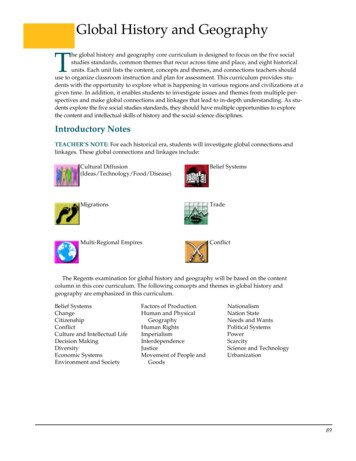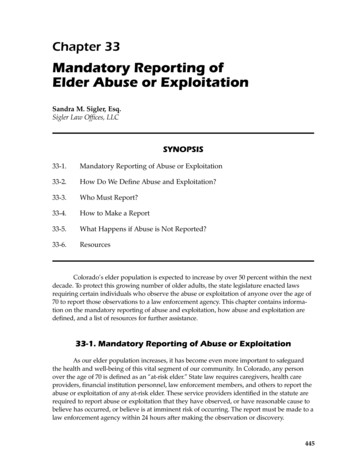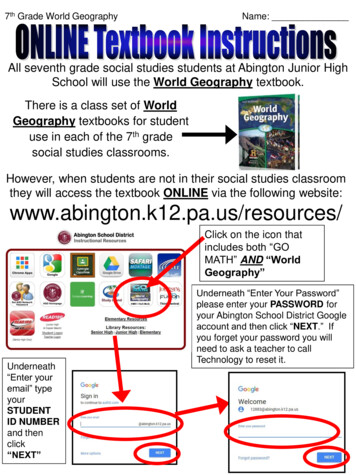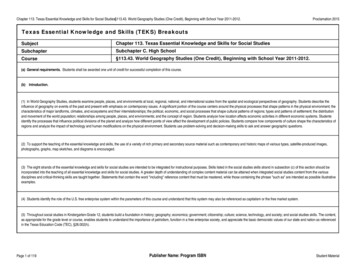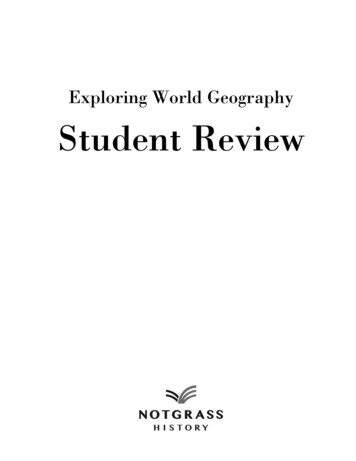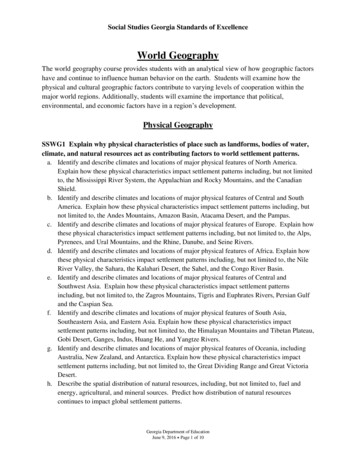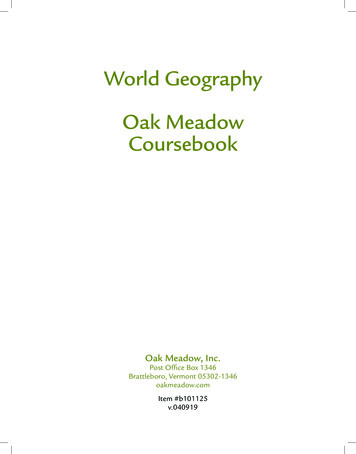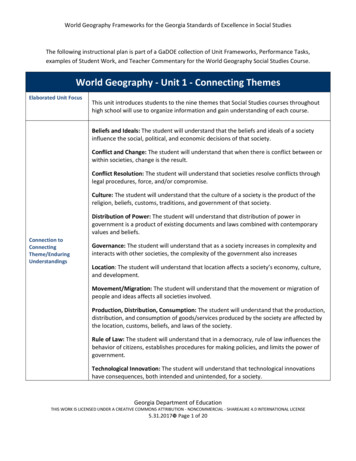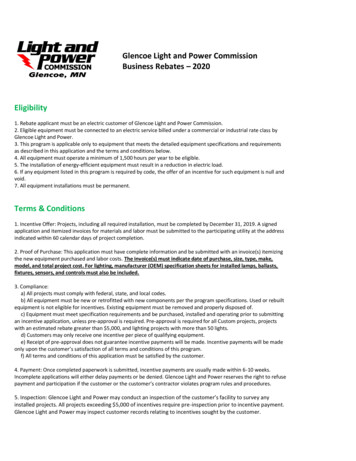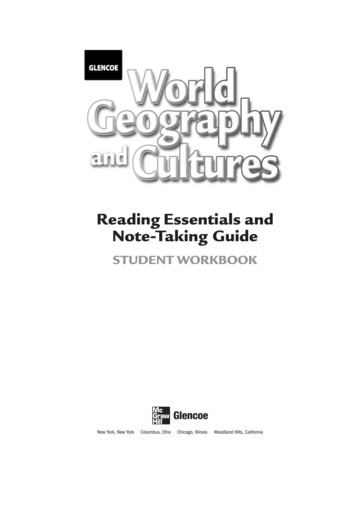
Transcription
Reading Essentials andNote-Taking GuideSTUDENT WORKBOOKWGC 08 RENTGSW RP 878389 14/3/07 11:57:16 AM
To the StudentThe World Geography and Cultures Reading Essentials and NoteTaking Guide is designed to help you use recognized reading strategies toimprove your reading-for-information skills. For each section of the studenttextbook, you are alerted to key content. Then, you are asked to draw fromprior knowledge, organize your thoughts with a graphic organizer, and follow a process to read and understand the text. The Reading Essentials andNote-Taking Guide was prepared to help you get more from your textbookby reading with a purpose.Copyright by The McGraw-Hill Companies, Inc. All rights reserved.Permission is granted to reproduce the material contained herein on thecondition that such material be reproduced only for classroom use; beprovided to students, teachers, and families without charge; and be usedsolely in conjunction with the World Geography and Cultures program.Any other reproduction, for sale or other use, is expressly prohibited.Send all inquiries to:Glencoe/McGraw-Hill8787 Orion PlaceColumbus, OH 43240-4027ISBN: 978-0-07-878389-0MHID: 0-07-878389-5Printed in the United States of America1 2 3 4 5 6 7 8 9 10 047 10 09 08 070ii 0iv RENTG FM 878389.indd ii4/3/07 10:34:57 AM
Table of ContentsChapter 1 How Geographers Look at the WorldSection 1: Geography Handbook .1Section 2: The Geographer’s Craft .4Chapter 2 The Physical WorldSection 1: Planet Earth .7Section 2: Forces of Change . 10Section 3: Earth’s Water . 13Chapter 3 Climates of the EarthSection 1: Earth-Sun Relationships .16Section 2: Factors Affecting Climate .19Section 3: World Climate Patterns . 22Chapter 4 The Human WorldSection 1: World Population . 25Section 2: Global Cultures . 28Section 3: Political and Economic Systems .31Section 4: Resources, Trade, and the Environment .34Chapter 5 Physical Geography of the United States and CanadaSection 1: The Land . 37Section 2: Climate and Vegetation .40Chapter 6 Cultural Geography of the United States and CanadaSection 1: The United States . 43Section 2: Canada . 46Chapter 7 The Region Today: The United States and CanadaSection 1: The Economy . 49Section 2: People and Their Environment .52Chapter 8 Physical Geography of Latin AmericaSection 1: The Land . 55Section 2: Climate and Vegetation .58Chapter 9 Cultural Geography of Latin AmericaSection 1: Mexico. 61Section 2: Central America and the Caribbean.64Section 3: South America . 67Chapter 10 The Region Today: Latin AmericaSection 1: The Economy . 70Section 2: People and Their Environment .73Chapter 11 Physical Geography of EuropeSection 1: The Land . 76Section 2: Climate and Vegetation .79Chapter 12 Cultural Geography of EuropeSection 1: Northern Europe . 82Section 2: Western Europe . 85Section 3: Southern Europe . 88Section 4: Eastern Europe .91iii0ii 0iv RENTG FM 878389.indd iii4/3/07 10:34:58 AM
Chapter 13 The Region Today: EuropeSection 1: The Economy . 94Section 2: People and Their Environment .97Chapter 14 Physical Geography of RussiaSection 1: The Land . 100Section 2: Climate and Vegetation . 103Chapter 15 Cultural Geography of RussiaSection 1: Population and Culture . 106Section 2: History and Government. 109Chapter 16 The Region Today: RussiaSection 1: The Economy . 112Section 2: People and Their Environment . 115Chapter 17 Physical Geography of North Africa, Southwest Asia,and Central AsiaSection 1: The Land . 118Section 2: Climate and Vegetation . 121Chapter 18 Cultural Geography of North Africa, Southwest Asia,and Central AsiaSection 1: North Africa . 124Section 2: The Eastern Mediterranean . 127Section 3: The Northeast . 130Section 4: The Arabian Peninsula . 133Section 5: Central Asia. 136Chapter 19 The Region Today: North Africa, Southwest Asia,and Central AsiaSection 1: The Economy . 139Section 2: People and Their Environment . 142Chapter 20 Physical Geography of Africa South of the SaharaSection 1: The Land . 145Section 2: Climate and Vegetation . 148Chapter 21 Cultural Geography of Africa South of the SaharaSection 1: The Sahel . 151Section 2: East Africa . 154Section 3: West Africa . 157Section 4: Central Africa . 160Section 5: Southern Africa . 163Chapter 22 The Region Today: Africa South of the SaharaSection 1: The Economy . 166Section 2: People and Their Environment . 169Chapter 23 Physical Geography of South AsiaSection 1: The Land . 172Section 2: Climate and Vegetation . 175iv0ii 0iv RENTG FM 878389.indd iv4/3/07 10:34:58 AM
Chapter 24 Cultural Geography of South AsiaSection 1: India . 178Section 2: Pakistan and Bangladesh . 181Section 3: Nepal, Bhutan, Maldives, and Sri Lanka. 184Chapter 25 The Region Today: South AsiaSection 1: The Economy . 187Section 2: People and Their Environment . 190Chapter 26 Physical Geography of East AsiaSection 1: The Land . 193Section 2: Climate and Vegetation . 196Chapter 27 Cultural Geography of East AsiaSection 1: China . 199Section 2: Japan . 202Section 3: North Korea and South Korea . 205Chapter 28 The Region Today: East AsiaSection 1: The Economy . 208Section 2: People and Their Environment . 211Chapter 29 Physical Geography of Southeast AsiaSection 1: The Land . 214Section 2: Climate and Vegetation . 217Chapter 30 Cultural Geography of Southeast AsiaSection 1: Mainland Southeast Asia . 220Section 2: Island Southeast Asia . 223Chapter 31 The Region Today: Southeast AsiaSection 1: The Economy . 226Section 2: People and Their Environment . 229Chapter 32 Physical Geography of Australia, Oceania, and AntarcticaSection 1: The Land . 232Section 2: Climate and Vegetation . 235Chapter 33 Cultural Geography of Australia and OceaniaSection 1: Australia and New Zealand . 238Section 2: Oceania . 241Chapter 34 The Region Today: Australia and OceaniaSection 1: The Economy . 244Section 2: People and Their Environment . 247v0ii 0iv RENTG FM 878389.indd v4/3/07 10:34:58 AM
0ii 0iv RENTG FM 878389.indd vi4/3/07 10:34:58 AM
Chapter 1, Section 1(Pages 4 –15)Geography HandbookGeography skills provide the tools for understanding relationshipsbetween people, places, and environments.Use a chart like the one below to identify the continents in each hemisphere. Continents may appear in more than one nContinentsCopyright Glencoe/McGraw-Hill, a division of The McGraw-Hill Companies, Inc.Globes and MapsRead the sectionand answer thequestions:1. Geographic information is shownmost accurately on a.2. Write a statementexpressing the mapscale 1:62,500:3. Circle latitude inthe following:29 25' N 98 30' WChapter 1, Section 1001 006 RENTG CH01 878389.indd 1(page 5)A globe is a scale model of Earth. A map is a symbolic representation of all or part of the planet. Cartographers are mapmakers. An imaginary line along the curve of Earth is called a greatcircle route. A map projection projects the round Earth onto aflat surface. The three basic categories of map projections areplanar, cylindrical, and conic. Interrupted projections resembleglobes that have been cut apart and laid flat. On globes, a gridsystem is formed by lines of latitude and lines of longitude.Geographers divide Earth into halves, called hemispheres. Northof the Equator is the Northern Hemisphere; south of the Equatoris the Southern Hemisphere; east of the Prime Meridian for180 is the Eastern Hemisphere; and west for 180 is theWestern Hemisphere.A map key explains symbols, colors, and lines used on amap; a scale bar shows the relationship between map measurements and actual distances on Earth; a compass rose indicatesthe four cardinal directions and sometimes intermediate directions. Scale relates measurements on a map with those onEarth’s surface. A line of latitude crossing a line of longitude isthe absolute location. The location of one place in relation toanother is relative location.14/3/07 10:41:24 AM
Types of MapsIdentify the correcttype of map for eachpurpose: physical,thematic or political.1. driving from NewYork City to Orlando,Florida2. identifying themajor agriculturalproducts of theUnited States(page 12)Physical maps show the location and topography, or shapeof Earth’s physical features. Physical maps show water features, suchas rivers, streams, and lakes; and landforms, such as mountains,plains, plateaus, and valleys. Shading and texture are used to showgeneral relief, differences in elevation, or height, of landforms.Some physical maps also show political features, such as boundarylines, countries, and states.Political maps show the boundaries and locations of politicalunits such as countries, states, counties, cities, and towns. Many features, including boundaries, capitals, cities, roads, highways, and railroads, are human-made, or determined by humans rather thannature. Physical features may also be shown on political maps.Nonsubject areas are usually set apart by a different color.Thematic maps emphasize a single idea or a particular kind ofinformation. Qualitative maps show information related to a specific idea. Flow-line maps illustrate the movement of people, animals, goods, and ideas, as well as physical processes.3. identifying desertareas of South AsiaWhich of the following are true aboutusing GIS to makemaps?a. many types ofdata can be shownb. GIS data sourcesare always accuratec. maps can berevised easily as newdata is collected2001 006 RENTG CH01 878389.indd 2(page 15)Most modern geographers use computers with software programs called geographic information systems (GIS) to makemaps. A GIS accepts data from different sources—maps, satelliteimages, printed text, and statistics—and converts the data intodigital code, which arranges it in a database. With GIS, eachkind of information on a map is saved as a separate electroniclayer. Cartographers use GIS to make maps and change themquickly and easily.Copyright Glencoe/McGraw-Hill, a division of The McGraw-Hill Companies, Inc.Geographic Information SystemsChapter 1, Section 14/3/07 10:41:25 AM
Answer these questions to check your understandingof the entire section.1. What are at least two of the concerns cartographers have when they select a map projection? Explain your reasoning.2. Identify two physical features, two human-made features, and two political features thatcould be shown on a typical urban-area map.Imagine that you are a city planner in a fast-growing urban area,and you are using GIS to create a map to help choose locations fornew elementary schools. What types of information would be useful?Write a paragraph about the features to be shown on the map.Copyright Glencoe/McGraw-Hill, a division of The McGraw-Hill Companies, Inc.I nformativeChapter 1, Section 1001 006 RENTG CH01 878389.indd 334/3/07 10:41:25 AM
Chapter 1, Section 2(Pages 16 –24)The Geographer’s CraftGeographers use six essential elements to organize and describe information about the Earth. Geographers study patterns of human and physicalgeography using direct observation, mapping, interviewing, statistics, andtechnology.As you read, complete a graphic organizer similar to the one below by listing the specialized research methods geographers use.ResearchMethodsWrite the letter of thecorrect definition nextto the correct term.a. movementb. sitec. ecosystemd. region1. location2. areas with similar characteristics3. community ofplants and animals4. how peoplesettle the Earth4001 006 RENTG CH01 878389.indd 4(page 17)Spatial relationships are the links people and places have to oneanother because of their locations. Site refers to the specific locationof a place, including its physical setting. Situation is an expressionof relative location. A place is a particular space with physical andhuman meaning. A region may be defined by similar physical andhuman characteristics. A formal region is defined by a commoncharacteristic, such as a product. A functional region is a centralplace and the surrounding area linked to it. A perceptual region isdefined by popular feelings and images rather than by objective data.Geographers study how physical features interact with plantsand animals to create, support, or change ecosystems, communitiesof plants and animals that depend upon one another, and their surroundings, for survival. Recurring themes in geography are theongoing movement of people, goods, and ideas, and humanenvironment interaction, or the study of the interrelationshipbetween people and their physical environment.Copyright Glencoe/McGraw-Hill, a division of The McGraw-Hill Companies, Inc.The Elements of GeographyChapter 1, Section 24/3/07 10:41:25 AM
Research MethodsPreview the section,then write a sentenceexplaining what youthink you will belearning.(page 21)Geographers study the Earth and patterns of human activitiesthrough direct observation. They also use remote sensing, such asaerial photographs or satellite images. Cartography involves designing and making maps, which show the location, features, patterns,and relationships of people, places, and things. Geographers usecomputers to organize and present numerical information, analyzethe data to find patterns and trends, and use statistical tests to seewhether their ideas are valid. Geographic information systems(GIS) are computer tools that process and organize data and satellite images with other types of information. Cartographers rely oncomputers to make maps, keeping each type of data on a separatedigital layer.Geography and Other SubjectsCopyright Glencoe/McGraw-Hill, a division of The McGraw-Hill Companies, Inc.As you read, writefour subjects geographers may study.Geographers use historical perspectives to understand whatplaces looked like in the past, and study political patterns to seehow different places are governed and how political boundarieshave formed and changed. They are interested in how the naturalenvironment has influenced political decisions and how governments change natural environments. Human geographers, or cultural geographers, use the tools of sociology and anthropology tounderstand world cultures. They study economies to understandhow the locations of resources affect the ways people make,transport, and use goods, and where services are provided. Theyare interested in the interdependence of people’s economic activities throughout the world.Geography as a CareerAs you read,write four careeropportunities forgeographers.Chapter 1, Section 2001 006 RENTG CH01 878389.indd 5(page 22)(page 23)Geographers have many career opportunities in teachingand education. Geographers also work as climate and weatherexperts, soil scientists, and environmental managers and technicians. Human geographers work in health care, transportation,population studies, economic development, and internationaleconomics. They may work as planners in local and state government agencies. Economic geographers examine human economic activities and their relationship to the environment. Aregional geographer studies the features of a particular regionand may assist government and businesses in making decisionsabout land use. Geographers also work as writers and editors.54/3/07 10:41:26 AM
Answer these questions to check your understandingof the entire section.1. What are the major branches of geography, and what topics does each branch study?2. How is geography used?Exposi toryConsider the place where you live. Write a paragraph describingits site, situation, and a type of region in which it belongs. Includeexamples of how the movement of people has affected its culture andhow human-environment interaction has changed the environment.Copyright Glencoe/McGraw-Hill, a division of The McGraw-Hill Companies, Inc.6001 006 RENTG CH01 878389.indd 6Chapter 1, Section 24/3/07 10:41:26 AM
Chapter 2, Section 1(Pages 30 –33)Planet EarthAs part of a larger system called the solar system, Earth has water, land,and air that make the planet suitable for plant and animal life.As you read about Earth, complete a graphic organizer similar to the onebelow by describing the four components of sphereDescriptionCopyright Glencoe/McGraw-Hill, a division of The McGraw-Hill Companies, Inc.Our Solar SystemScan the sectionbefore you begin toread. Look for keywords or phrasesthat will tell youwhat the text willcover. Write the keywords or phrases:Chapter 2, Section 1007 015 RENTG CH02 878389.indd 7(page 31)Our solar system is made up of the sun and all the objectsthat revolve around it. The sun, the center of the solar system, isa ball of burning gases. The huge amount of matter containedin the sun creates a strong pull of gravity, which keeps Earthand other objects revolving around the sun.Except for the sun, planets are the largest objects in thesolar system. The inner planets, Mercury, Venus, Earth, andMars, are called terrestrial planets. The outer planets, Jupiter,Saturn, Uranus, and Neptune, are the gas giant planets. Ceresand Pluto are dwarf planets.Other objects that revolve around the sun include asteroids,comets, and meteoroids. Asteroids are small, irregularly shaped,planet-like objects. Comets are made of icy dust particles andfrozen gases. Meteoroids are chunks of rock and iron.74/3/07 10:40:35 AM
Getting to Know EarthAs you read the lesson, write downquestions you haveabout what youread. When you havefinished reading thelesson, answer yourquestions.007 015 RENTG CH02 878389.indd 8The Earth has a larger diameter at the Equator than from Pole toPole, but the difference is less than 1 percent.The surface of Earth is made up of water and land. About70 percent of Earth’s surface is water. Earth’s hydrosphere consistsof bodies of water, such as oceans, lakes, and rivers. About 30 percent of Earth’s surface is land, or lithosphere. The lithosphere alsoincludes the land beneath the oceans. Earth’s atmosphere is a layerof gases extending above Earth’s surface. Gases in the atmosphereinclude nitrogen, oxygen, and small amounts of argon and othergases. The part of Earth that supports life is the biosphere.The natural features of Earth’s surface are called landforms.Landforms are found on Earth’s surface and under water. Seen fromspace, Earth’s most visible landforms are the seven landmassescalled continents. Australia and Antarctica stand alone. Europe andAsia are parts of one landmass called Eurasia. The Isthmus ofPanama joins North and South America. At the Sinai Peninsula, theSuez Canal separates Africa and Asia. The continental shelf is anextension of the coastal plain.Earth has great differences in the heights and depths of its surface. Mount Everest is the highest point at 29,035 feet (8,850 m)above sea level. The shore of the Dead Sea is the lowest point ondry land, at 1,349 feet (411 m) below sea level. Earth’s deepestknown depression lies in the Mariana Trench, a narrow underwatercanyon about 35,827 feet (10,920 m) deep.Copyright Glencoe/McGraw-Hill, a division of The McGraw-Hill Companies, Inc.8(page 32)Chapter 2, Section 14/3/07 10:40:36 AM
Answer these questions to check your understandingof the entire section.1. Describe the different surfaces and geographical areas found on Earth.2. What point on Earth is the greatest distance from sea level?Copyright Glencoe/McGraw-Hill, a division of The McGraw-Hill Companies, Inc.Agree or disagree with the statement: When small objects in space,such as meteoroids and comets, enter Earth’s atmosphere, they haveno long-term effect on Earth’s lithosphere, atmosphere, or biosphere.Justify your conclusion.Chapter 2, Section 1007 015 RENTG CH02 878389.indd 994/3/07 10:40:36 AM
Chapter 2, Section 2(Pages 34–40)Forces of ChangeThe surface of the Earth has been shaped by the internal forces of tectonicactivity as well as by the external forces of weathering and erosion.As you read about the forces that change the Earth, use the major headings of the section to create an outline similar to the one below.Forces of ChangeI. Earth’s StructureA.B.II. Internal Forces of ChangeA.B.As you read, fill inthe blanks.Earth’s crust is broken into slabs ofrock calledThe theory that thecontinents were oncejoined then driftedapart is called10007 015 RENTG CH02 878389.indd 10(page 35)Earth is made of three layers. The core is at the center of theEarth. The mantle is a thick layer of hot, solid rock. The crust is arocky shell that forms Earth’s surface, and is broken into slabs ofrock, called plates, that float on a layer in the mantle.According to the theory of continental drift, all landmasseson Earth were once a supercontinent. The supercontinent brokedown into smaller continents that have drifted apart and, in someplaces, recombined.Many scientists believe that plate tectonics, the movement ofplates of Earth’s crust, created Earth’s largest features. Plates are constantly moving and shaping the planet. As the plates move, theycrash into each other, pull apart, or grind and slide past each other.When the plates spread apart, magma, or melted rock, pushes upfrom the mantle. Scientists estimate that plate tectonics has shapedEarth’s surface for 2.5 to 4 billion years. However, scientists have notyet determined exactly what causes plate tectonics.Copyright Glencoe/McGraw-Hill, a division of The McGraw-Hill Companies, Inc.Earth’s StructureChapter 2, Section 24/3/07 10:40:37 AM
Internal Forces of ChangeAs you read this section, think aboutwhat facts you findinteresting or surprising, and writethem down.Internal forces change the surface of Earth: mountains formwhen continental plates collide and when a sea plate collideswith a continental plate in a process called subduction. Wherecontinental and sea plates collide, pieces of Earth’s crust cometogether slowly as the sea plate slides under the continentalplate in a process called accretion. This movement can causecontinents to grow outward. Spreading is a process in whichsea plates pull apart, releasing magma.Moving plates can sometimes squeeze the Earth’s surface,causing folds, or bends in layers of rock. Grinding or slidingplates create cracks in the Earth’s crust called faults. Earthquakes are caused by sudden, violent movements of tectonicplates along a fault line.Volcanic eruptions can occur when one plate plungesbeneath another. Volcanoes can also occur far from plate boundaries where magma from hot areas deep in the Earth blaststhrough the surface.Copyright Glencoe/McGraw-Hill, a division of The McGraw-Hill Companies, Inc.External Forces of ChangeRead the title andmain headings ofthe section. Write astatement predictingwhat the lesson willbe about and whatwill be included inthe text.Chapter 2, Section 2007 015 RENTG CH02 878389.indd 11(page 36)(page 39)External forces, such as wind and water, change Earth’s surface. Physical weathering occurs when large masses of rock arebroken down into smaller pieces. Chemical weathering changesthe chemical makeup of rocks, as when rainwater containingcarbon dioxide dissolves rocks.Wind erosion is caused when winds pick up large amountsof soil and blow it away. Glacial erosion occurs when glacierspick up rocks and soil as they move slowly downhill. When glaciers melt and recede, they can leave behind large piles of rocksand debris called moraines. Moraines can form long ridges ofland or form dams that hold water back and create glacial lakes.Water erosion is caused when streams of springwater orrainwater flow downhill, cutting into the land and wearing awaysoil and rock. The sediment then grinds away the surface ofrocks along the stream’s path. Over time, valleys and canyonsare formed.114/3/07 10:40:37 AM
Answer these questions to check your understandingof the entire section.1. How do Earth’s layers contribute to the planet’s physical characteristics?2. How do internal forces of change affect Earth’s surface differently from external forces ofchange?Exposi toryDescribe how internal forces may have changed the surface of what isnow North America over the past 225 million years.Copyright Glencoe/McGraw-Hill, a division of The McGraw-Hill Companies, Inc.12007 015 RENTG CH02 878389.indd 12Chapter 2,
The World Geography and Cultures Reading Essentials and Note- . For each section of the student textbook, you are alerted to key content. Then, you are asked to draw from prior knowledge, organize your thoughts with a graphic organizer, and fol-low a process to read and understand the text. The Reading Essentials and
